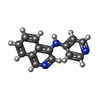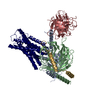+Search query
-Structure paper
| Title | Structure-based discovery of nonopioid analgesics acting through the α-adrenergic receptor. |
|---|---|
| Journal, issue, pages | Science, Vol. 377, Issue 6614, Page eabn7065, Year 2022 |
| Publish date | Sep 30, 2022 |
 Authors Authors | Elissa A Fink / Jun Xu / Harald Hübner / Joao M Braz / Philipp Seemann / Charlotte Avet / Veronica Craik / Dorothee Weikert / Maximilian F Schmidt / Chase M Webb / Nataliya A Tolmachova / Yurii S Moroz / Xi-Ping Huang / Chakrapani Kalyanaraman / Stefan Gahbauer / Geng Chen / Zheng Liu / Matthew P Jacobson / John J Irwin / Michel Bouvier / Yang Du / Brian K Shoichet / Allan I Basbaum / Peter Gmeiner /       |
| PubMed Abstract | Because nonopioid analgesics are much sought after, we computationally docked more than 301 million virtual molecules against a validated pain target, the α-adrenergic receptor (αAR), seeking new ...Because nonopioid analgesics are much sought after, we computationally docked more than 301 million virtual molecules against a validated pain target, the α-adrenergic receptor (αAR), seeking new αAR agonists chemotypes that lack the sedation conferred by known αAR drugs, such as dexmedetomidine. We identified 17 ligands with potencies as low as 12 nanomolar, many with partial agonism and preferential G and G signaling. Experimental structures of αAR complexed with two of these agonists confirmed the docking predictions and templated further optimization. Several compounds, including the initial docking hit '9087 [mean effective concentration (EC) of 52 nanomolar] and two analogs, '7075 and PS75 (EC 4.1 and 4.8 nanomolar), exerted on-target analgesic activity in multiple in vivo pain models without sedation. These newly discovered agonists are interesting as therapeutic leads that lack the liabilities of opioids and the sedation of dexmedetomidine. |
 External links External links |  Science / Science /  PubMed:36173843 / PubMed:36173843 /  PubMed Central PubMed Central |
| Methods | EM (single particle) |
| Resolution | 3.4 - 3.47 Å |
| Structure data | EMDB-32331, PDB-7w6p: EMDB-32342, PDB-7w7e: |
| Chemicals |  ChemComp-W96:  ChemComp-W58: |
| Source |
|
 Keywords Keywords | MEMBRANE PROTEIN / GPCR / G-protein / signaling complex / biased agonist |
 Movie
Movie Controller
Controller Structure viewers
Structure viewers About Yorodumi Papers
About Yorodumi Papers







 homo sapiens (human)
homo sapiens (human)
